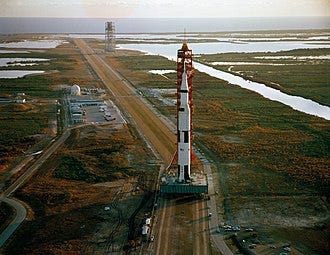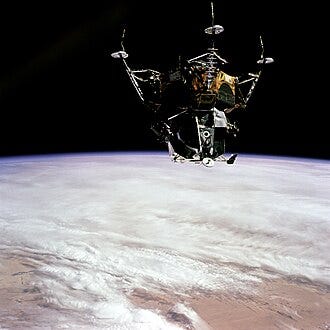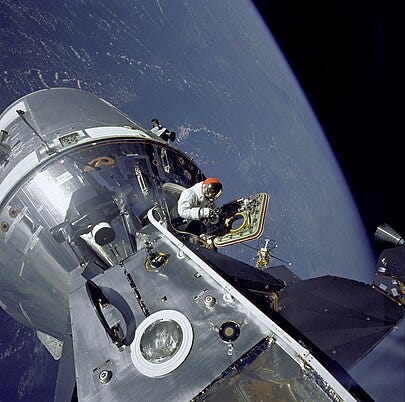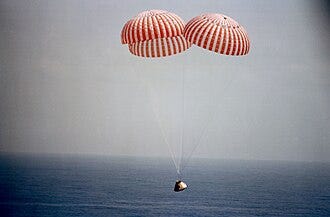March 3, 1969 11:00am
Crew: James McDivitt, David Scott, Rusty Schweickart
Duration: 10 days, 1 hour, 54 seconds
As 1969 began, the pressure was rising. Apollo 9 was set for a launch in March to test the Lunar Module in orbit. But problems with the Lunar Module, which had already forced the change in the Apollo 8 mission, lingered. The wiring of LM-3, designated for the Apollo 9 mission, was cause for some concern but was eventually judged to be safe enough for the mission.
Another challenge was the fact that crews at Kennedy had their hands full, first getting Apollo 8 assembled and launched, while simultaneously checking out the components for Apollo 9 and Apollo 10. Fortunately for them, the early plan to launch the Apollo 9 mission using two Saturn IB boosters had been changed to using a single Saturn V.
On January 3rd, just a week after the Apollo 8 splashdown, the Apollo 9 stack rolled out of the VAB to Launch Complex 39. For the first time, the Saturn V would launch fully operational versions of the CSM and the LM. By the end of February, all of the technical and engineering issues had been worked out.
For the first time since Gemini 3, NASA allowed the crew to give their spacecraft nicknames. They called the Lunar Module ‘Spider’ because of its spindly legs. The CSM was named ‘Gumdrop,’ both for its shape and the blue color of its protective wrapping.
Lift-off came at 11:00 am on March 3rd. The first stage performed well, “an old lady’s ride,” according to Commander Jim McDivitt. Two minutes and forty-five seconds into the flight, the S-II second stage took over, and the ride got bumpier as pogo set in. The third stage S-IVB engines ignited at eight-minute and fifty-seven seconds after launch, and after burning for just over two minutes, the stack was in orbit.
After ensuring that all systems were operating correctly, it was time to retrieve the Lunar Module from its protective shell atop the S-IVB. The docking probe was extended, and Command Module Pilot maneuvered the Gumdrop in for a hard dock. After confirming everything was okay, Apollo 9 pulled away from the S-IVB.
Now, they tested the Service Module Engine for the first of several times. The question was whether the CSM could maneuver successfully with the docked Lunar Module. The tests settled the question and raised the combined spacecraft orbit to an altitude of 316 miles.
For the first time, NASA let the crew sleep at the same time. The next morning, they prepared for the next major test. The crew got into their pressure suits. Scott opened the docking hatch and removed the CSM probe and the LM drogue from the tunnel. Schweickart pulled himself through the tunnel, opened the LM hatch and entered the lander. McDivitt followed about an hour later, and Scott closed the hatches.
Schweickart and McDivitt ran through their checklist. They activated Spider’s landing legs, which sprang into position. McDivitt used the LM thrusters to maneuver into position and then fired up the Descent engine. The result was better than expected. Afterward, Spider was shut down, and McDivitt and Schweickart returned to Gumdrop.
On their fourth day in orbit, Schweickart suited up again and entered Spider. He was wearing the portable life support system backpack that would later be used on the landing missions. Tethered to LM, Schweickart opened Spider’s front hatch and stepped out on to ‘the porch.’
At that point, Scott opened Gumdrop’s hatch and stood up. Both astronauts took pictures of each other and retrieved experiment samples. The spacewalks lasted less than an hour, and the crew returned to Gumdrop to rest.
The next day, March 7th, they began the ultimate test. Scott remained in the CSM, while McDivitt and Schweickart returned to the LM. Scott released Spider, and McDivitt spun the LM around to let Scott check if the legs had properly deployed. Then Spider departed. McDivitt piloted the LM to an eventual distance of 115 miles from the CSM. Again and again, they tested the descent engine and the thrusters. They jettisoned the descent stage and fired up the ascent engine and returned to Gumdrop. They docked safely, ending their six-hour excursion.
The next few days were much easier. The crew would conduct further burns with the SPS, take pictures, and perform navigation sightings. On March 13th, Gumdrop came home, splashing down within sight of the recovery ship east of the Bahamas.










thank you for doing this Micheal, I am fascinated and read each one with rapt attention...nice way to revisit the Apollo Program! cheers, Lloyd